The Auxiliary Effect of Copper Ions on the Depressant Effect of Sodium Thioglycolate in Chalcopyrite Flotation
Abstract
:1. Introduction
2. Materials and Methods
2.1. Mineral Samples and Reagents
2.2. Micro-Flotation Tests
2.3. Zeta Potential Measurements
2.4. XPS Measurements
2.5. FTIR Spectra Measurements
3. Results
3.1. Micro-Flotation Results
3.2. Zeta Potential Measurement Results
3.3. X-Ray Photoelectron Spectroscopy (XPS) Results
3.4. FTIR Studies
4. Conclusions
Author Contributions
Funding
Conflicts of Interest
References
- Córdoba, E.M.; Muñoz, J.A.; Blázquez, M.L.; González, F.; Ballester, A. Hydrometallurgy Leaching of chalcopyrite with ferric ion. Part I: General aspects. Hydrometallurgy 2008, 93, 81–87. [Google Scholar] [CrossRef]
- Pearse, M.J. An overview of the use of chemical reagents in mineral processing. Miner. Eng. 2005, 18, 139–149. [Google Scholar] [CrossRef]
- Zhang, C.; Li, L.; Yuan, Z.; Xu, X.; Song, Z.; Zhang, Y.R. Mechanical properties of siderite and hematite from DFT calculation. Miner. Eng. 2019, 146, 106107. [Google Scholar] [CrossRef]
- Liu, Y.; Liu, Q. Flotation separation of carbonate from sulfide minerals, II: Mechanisms of flotation depression of sulfide minerals by thioglycollic acid and citric acid. Miner. Eng. 2004, 17, 865–878. [Google Scholar] [CrossRef]
- Tadie, M.; Corin, K.C.; Wiese, J.G.; O’Connor, C.T. Electrochemical interactions of platinum group minerals with copper sulphate. Miner. Eng. 2017, 112, 43–49. [Google Scholar] [CrossRef]
- Feng, B.; Zhong, C.; Zhang, L.; Guo, Y.; Wang, T.; Huang, Z. Effect of surface oxidation on the depression of sphalerite by locust bean gum. Miner. Eng. 2020, 146, 106142. [Google Scholar] [CrossRef]
- Chandra, A.P.; Gerson, A.R. A review of the fundamental studies of the copper activation mechanisms for selective fl otation of the sul fi de minerals, sphalerite and pyrite. Adv. Colloid Interface Sci. 2009, 145, 97–110. [Google Scholar] [CrossRef]
- Zhao, Q.; Liu, W.; Wei, D.; Wang, W.; Cui, B.; Liu, W. Effect of copper ions on the fl otation separation of chalcopyrite and molybdenite using sodium sul fi de as a depressant. Miner. Eng. 2018, 115, 44–52. [Google Scholar] [CrossRef]
- Cao, Q.; Chen, X.; Feng, Q.; Wen, S. Activation mechanism of lead ion in the fl otation of stibnite. Miner. Eng. 2018, 119, 173–182. [Google Scholar] [CrossRef]
- Fu, Y.; Zhu, Z.; Yao, J.; Han, H.; Yin, W.; Yang, B. Improved depression of talc in chalcopyrite flotation using a novel depressant combination of calcium ions and sodium lignosulfonate. Colloids Surfaces A 2018, 558, 88–94. [Google Scholar] [CrossRef]
- Liu, C.; Zhu, G.; Song, S.; Li, H. Flotation separation of smithsonite from quartz using calcium lignosulphonate as a depressant and sodium oleate as a collector. Miner. Eng. 2019, 131, 385–391. [Google Scholar] [CrossRef]
- Feng, Q.; Zhao, W.; Wen, S. Applied Surface Science Surface modification of malachite with ethanediamine and its effect on sulfidization flotation. Appl. Surf. Sci. 2018, 436, 823–831. [Google Scholar] [CrossRef]
- Jia, Y.; Huang, K.; Wang, S.; Cao, Z.; Zhong, H. The selective fl otation behavior and adsorption mechanism of thiohexanamide to chalcopyrite. Miner. Eng. 2019, 137, 187–199. [Google Scholar] [CrossRef]
- Yao, J.; Xue, J.; Yin, W.; Chu, W.; Zhu, Z.; Yang, B. Recovery of digenite from heavily oxidized Cu-S ore using Na 2 S as an activator. Miner. Eng. 2019, 134, 317–324. [Google Scholar] [CrossRef]
- Cao, Z.; Chen, X.; Peng, Y. The role of sodium sul fi de in the fl otation of pyrite depressed in chalcopyrite fl otation. Miner. Eng. 2018, 119, 93–98. [Google Scholar] [CrossRef]
- Zhao, H.; Wang, J.; Gan, X.; Hu, M.; Zhang, E.; Qin, W.; Qiu, G. Cooperative bioleaching of chalcopyrite and silver-bearing tailing by mixed moderately thermophilic culture: An emphasis on the chalcopyrite dissolution with XPS and electrochemical analysis. Miner. Eng. 2015, 81, 29–39. [Google Scholar] [CrossRef]
- Jürgensen, A.; Raschke, H.; Esser, N.; Hergenröder, R. Applied Surface Science An in situ XPS study of L-cysteine co-adsorbed with water on polycrystalline copper and gold. Appl. Surf. Sci. 2018, 435, 870–879. [Google Scholar] [CrossRef]
- Ghahremaninezhad, A.; Dixon, D.G.; Asselin, E. Electrochemical and XPS analysis of chalcopyrite (CuFeS2) dissolution in sulfuric acid solution. Electrochim. Acta 2013, 87, 97–112. [Google Scholar] [CrossRef]
- Yang, B.; Wang, D.; Wang, T.; Zhang, H.; Jia, F.; Song, S. Effect of Cu2+ and Fe3+ on the depression of molybdenite in fl otation. Miner. Eng. 2019, 130, 101–109. [Google Scholar] [CrossRef]
- Lu, J.; Tong, Z.; Yuan, Z.; Li, L. Investigation on fl otation separation of chalcopyrite from arsenopyrite with a novel collector: N-Butoxycarbonyl-O-Isobutyl Thiocarbamate. Miner. Eng. 2019, 137, 118–123. [Google Scholar] [CrossRef]
- Qin, W.; Jiao, F.; Sun, W.; He, M.; Huang, H. Selective flotation of chalcopyrite and marmatite by MBT and electrochemical analysis. Ind. Eng. Chem. Res. 2012, 51, 11538–11546. [Google Scholar] [CrossRef]
- Zeng, W.; Qiu, G.; Chen, M. Hydrometallurgy Investigation of Cu—S intermediate species during electrochemical dissolution and bioleaching of chalcopyrite concentrate. Hydrometallurgy 2013, 134–135, 158–165. [Google Scholar] [CrossRef]
- Yang, Y.; Harmer, S.; Chen, M. Synchrotron-based XPS and NEXAFS study of surface chemical species during electrochemical oxidation of chalcopyrite. Hydrometallurgy 2015, 156, 89–98. [Google Scholar] [CrossRef]
- Liu, S.; Liu, G.; Zhong, H.; Yang, X. Journal of Industrial and Engineering Chemistry The role of HABTC’ s hydroxamate and dithiocarbamate groups in chalcopyrite fl otation. J. Ind. Eng. Chem. 2017, 52, 359–368. [Google Scholar] [CrossRef]
- Plackowski, C.; Bruckard, W.J.; Nguyen, A.V. Surface characterisation, collector adsorption and flotation response of enargite in a redox potential controlled environment. Miner. Eng. 2014, 65, 61–73. [Google Scholar] [CrossRef]
- Sritham, E.; Gunasekaran, S. Food Hydrocolloids FTIR spectroscopic evaluation of sucrose-maltodextrin-sodium citrate bioglass. Food Hydrocoll. 2017, 70, 371–382. [Google Scholar] [CrossRef]
- Kets, E.P.W.; Ijpelaar, P.J.; Hoekstra, F.A.; Vromans, H. Citrate increases glass transition temperature of vitrified sucrose preparations. Cryobiology 2004, 48, 46–54. [Google Scholar] [CrossRef]
- Sadat, F.; Rezai, B.; Kowsari, E. The main factors effecting the ef fi ciency of Zn (II) flotation: Optimum conditions and separation mechanism. J. Environ. Manag. 2018, 207, 169–179. [Google Scholar]
- Yin, Z.; Xu, L.; He, J.; Wu, H.; Fang, S.; Ahmed, S.; Hu, Y.; Sun, W. Evaluation of L -cysteine as an eco-friendly depressant for the selective separation of MoS 2 from PbS by fl otation. J. Mol. Liq. 2019, 282, 177–186. [Google Scholar] [CrossRef]
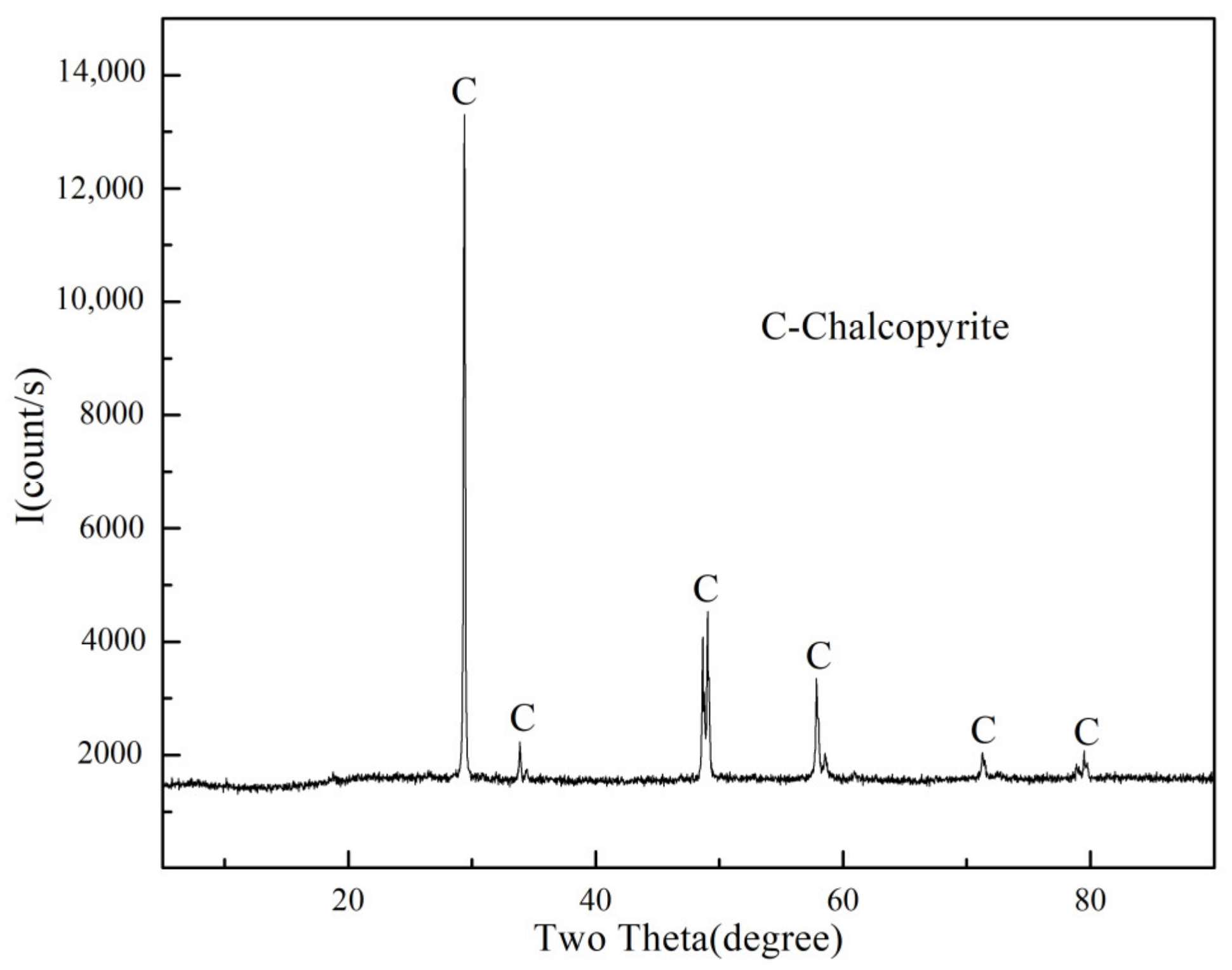
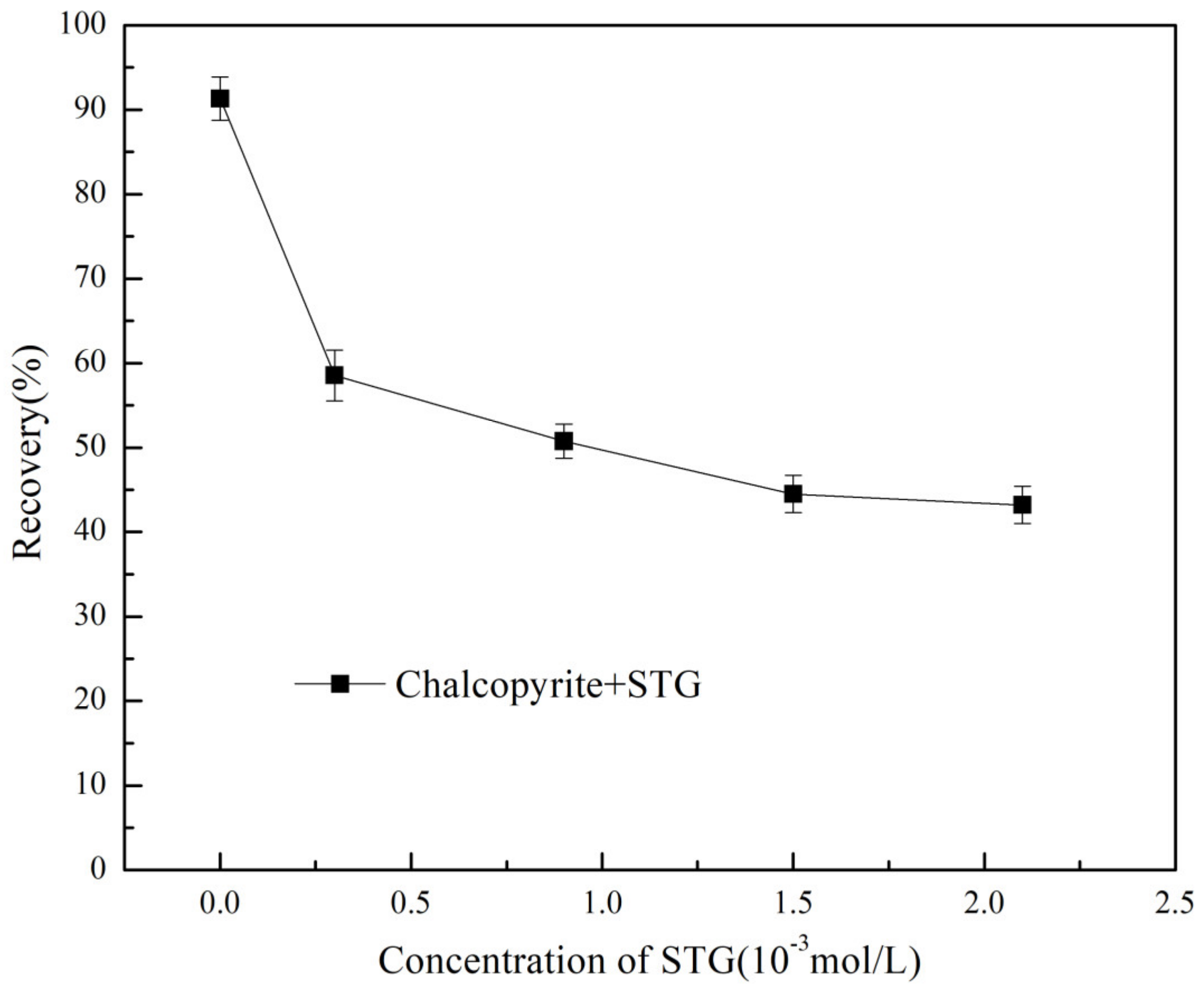
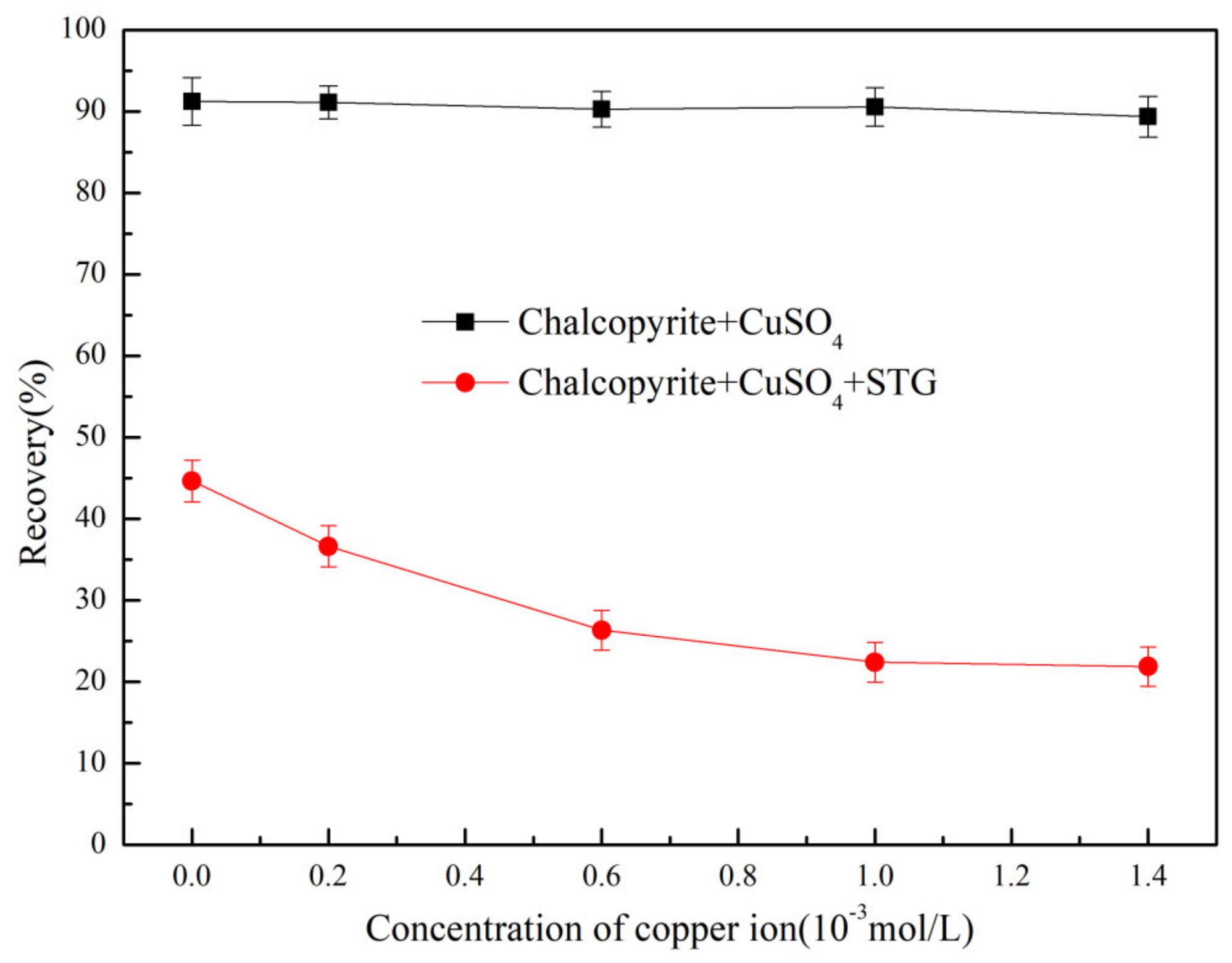
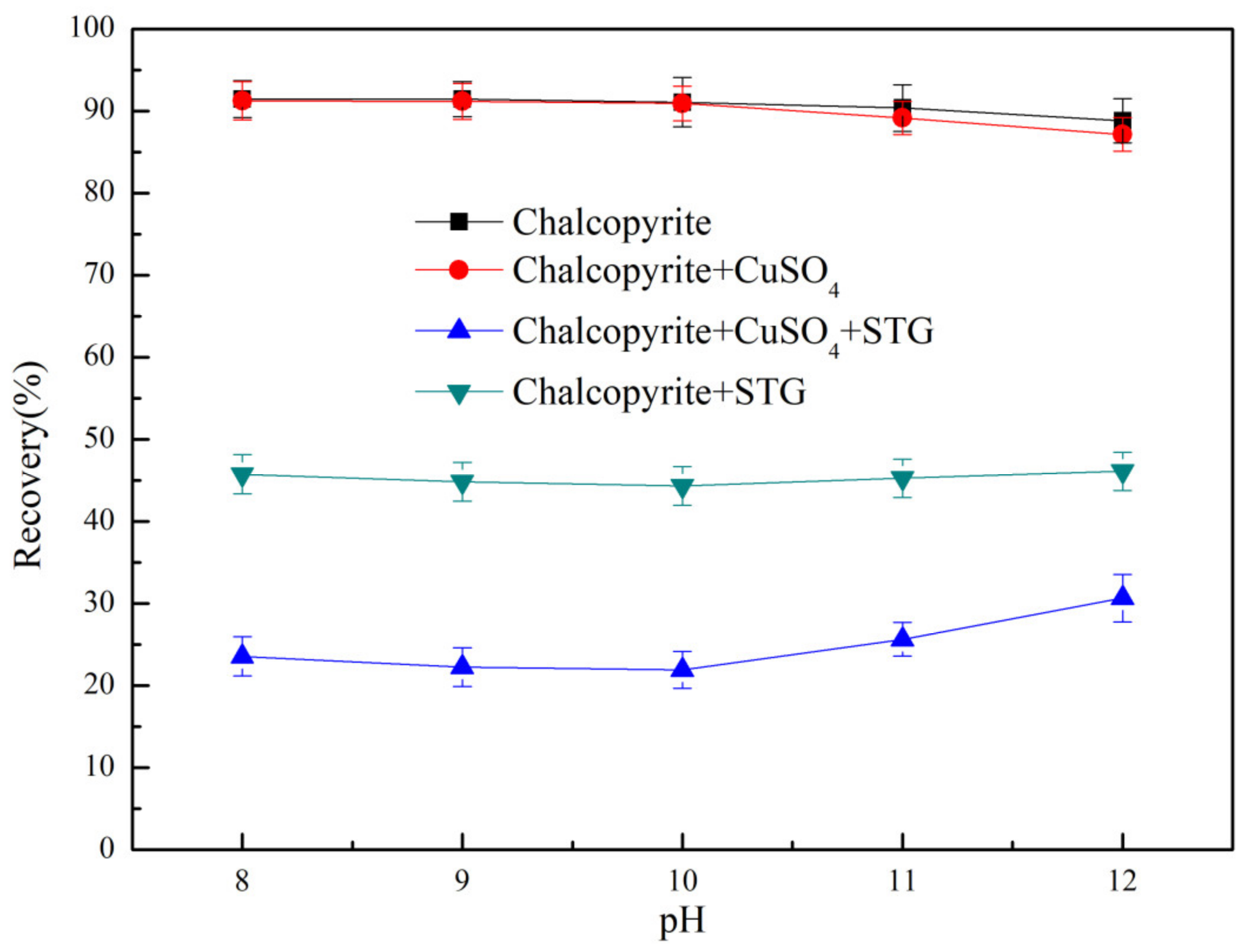
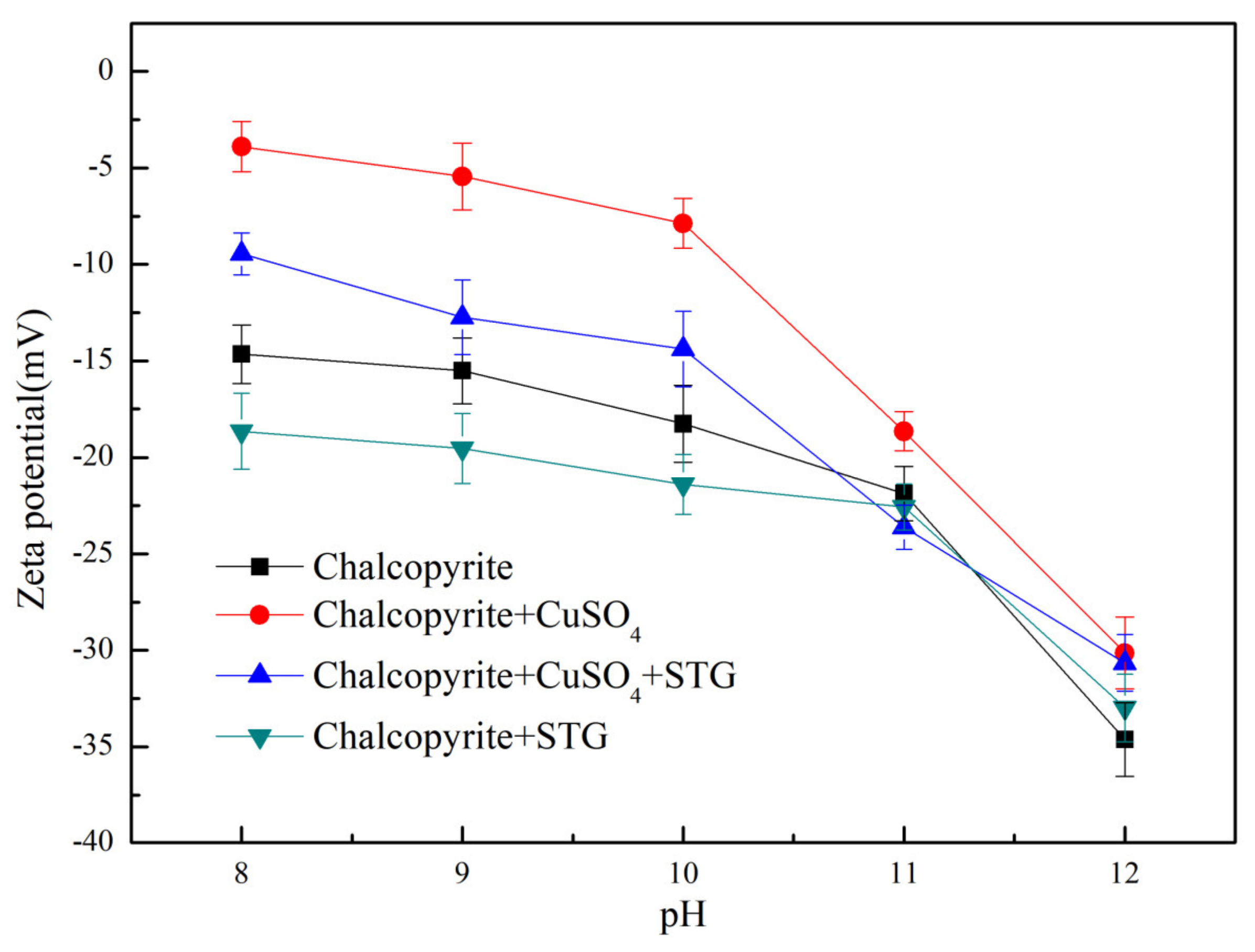
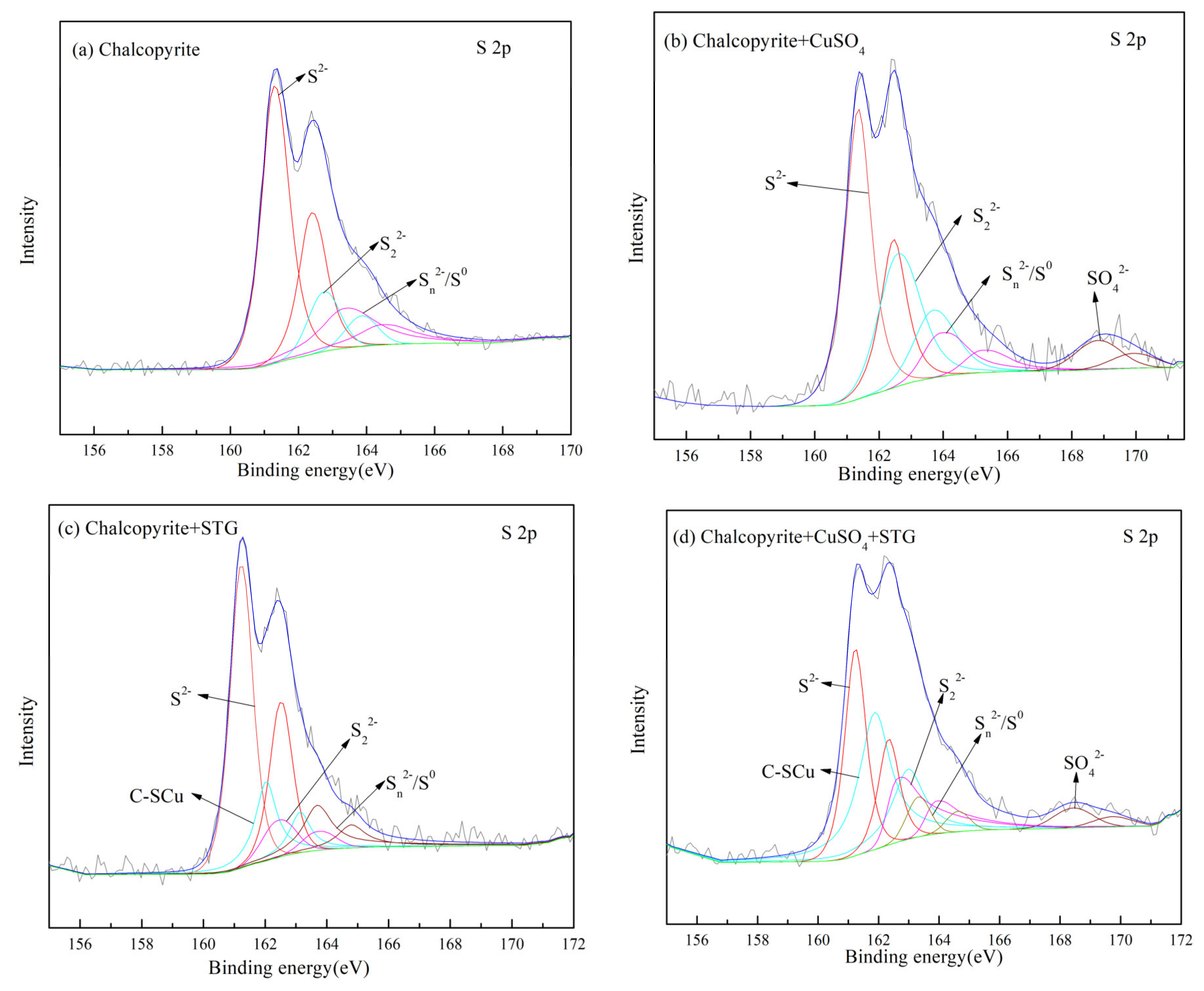
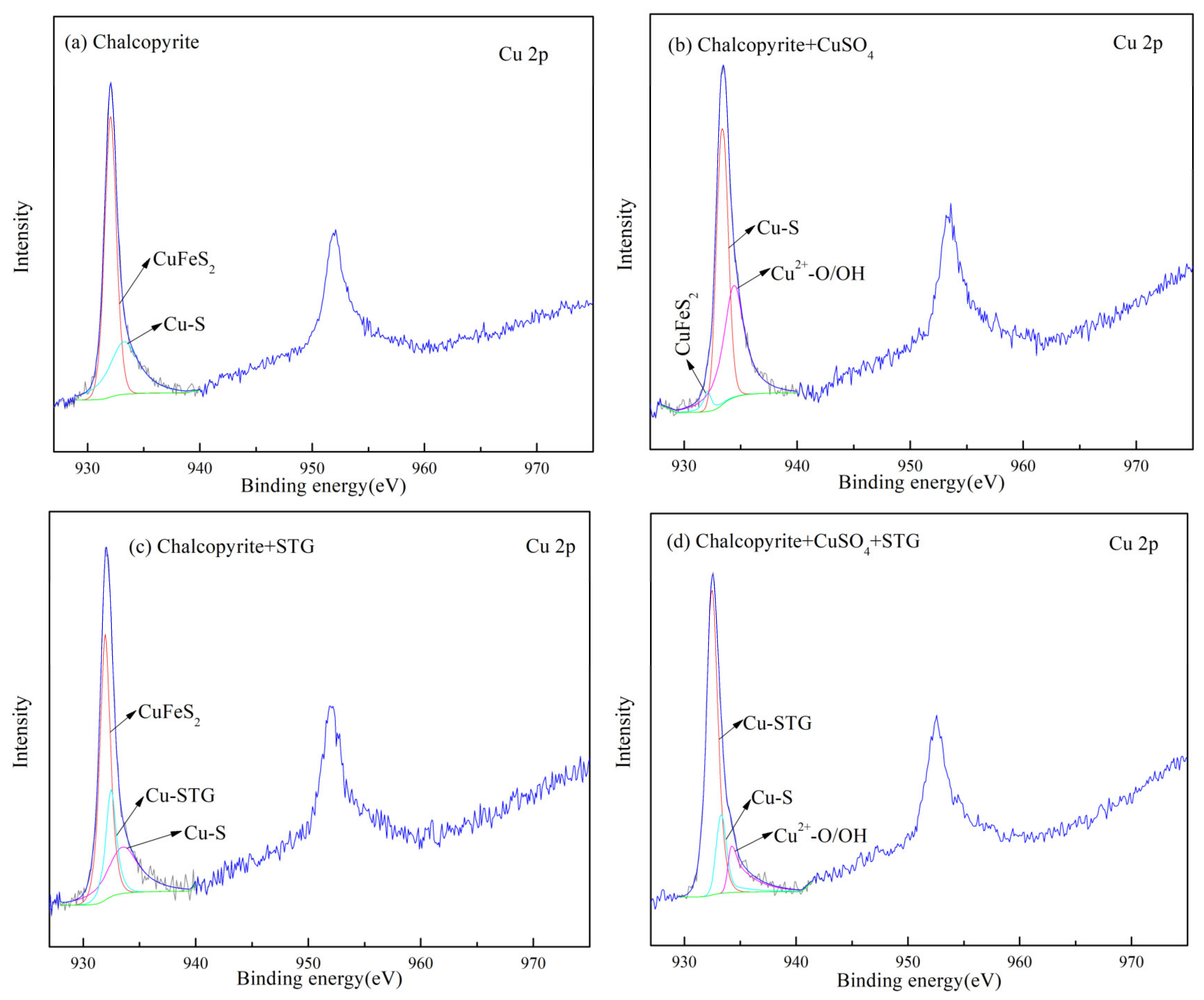

| Chemical Composition | Cu | Fe | S | Other |
|---|---|---|---|---|
| Content (%) | 33.23 | 29.34 | 33.58 | 3.85 |
| Species | Binding Energy/eV | FWHM/eV | Percentage/% | Assignment |
|---|---|---|---|---|
| Chalcopyrite | 161.27/162.37 | 0.88 | 63.52 | S2− |
| 162.75/163.85 | 1.1 | 14.39 | S22− | |
| 163.34/164.44 | 1.68 | 22.08 | Sn2−/S0 | |
| Chalcopyrite + Cu | 161.35/162.45 | 0.98 | 47.68 | S2− |
| 162.58/163.68 | 1.46 | 33.00 | S22− | |
| 163.92/165.22 | 1.25 | 11.98 | Sn2−/S0 | |
| 168.83/169.93 | 1.65 | 7.36 | ||
| Chalcopyrite + STG | 161.21/162.49 | 0.86 | 55.63 | S2− |
| 162.03/163.13 | 0.82 | 18.49 | C-SCu | |
| 162.40/163.70 | 1.17 | 9.27 | S22− | |
| 163.69/164.79 | 1.07 | 16.62 | Sn2−/S0 | |
| Chalcopyrite + Cu + STG | 161.24/162.34 | 0.83 | 30.70 | S2− |
| 161.88/162.98 | 1.25 | 39.36 | C-SCu | |
| 162.64/163.91 | 1.41 | 17.14 | S22− | |
| 163.32/164.62 | 0.90 | 5.35 | Sn2−/S0 | |
| 168.44/169.74 | 1.51 | 4.47 |
| Species | Binding Energy/eV | FWHM/eV | Percentage/% | Assignment |
|---|---|---|---|---|
| Chalcopyrite | 932.05 | 1.27 | 65.30 | CuFeS2 |
| 933.26 | 3.17 | 34.70 | CuS, | |
| Chalcopyrite + Cu | 932.06 | 0.79 | 3.36 | CuFeS2 |
| 933.24 | 1.23 | 51.66 | CuS, | |
| 934.40 | 2.16 | 44.98 | Cu2+-O/OH | |
| Chalcopyrite + STG | 931.94 | 1.05 | 52.04 | CuFeS2 |
| 932.49 | 1.28 | 31.34 | Cu-STG | |
| 933.78 | 2.10 | 16.62 | CuS | |
| Chalcopyrite + Cu + STG | 932.44 | 1.21 | 68.15 | Cu-STG |
| 933.30 | 1.10 | 16.60 | CuS, | |
| 934.22 | 1.37 | 15.26 | Cu2+-O/OH |
© 2020 by the authors. Licensee MDPI, Basel, Switzerland. This article is an open access article distributed under the terms and conditions of the Creative Commons Attribution (CC BY) license (http://creativecommons.org/licenses/by/4.0/).
Share and Cite
Zhang, C.; He, T.; Chen, W.; Bu, X.; Wang, S.; Tian, X. The Auxiliary Effect of Copper Ions on the Depressant Effect of Sodium Thioglycolate in Chalcopyrite Flotation. Minerals 2020, 10, 157. https://doi.org/10.3390/min10020157
Zhang C, He T, Chen W, Bu X, Wang S, Tian X. The Auxiliary Effect of Copper Ions on the Depressant Effect of Sodium Thioglycolate in Chalcopyrite Flotation. Minerals. 2020; 10(2):157. https://doi.org/10.3390/min10020157
Chicago/Turabian StyleZhang, Chonghui, Tingshu He, Wei Chen, Xianzhong Bu, Sen Wang, and Xiaozhen Tian. 2020. "The Auxiliary Effect of Copper Ions on the Depressant Effect of Sodium Thioglycolate in Chalcopyrite Flotation" Minerals 10, no. 2: 157. https://doi.org/10.3390/min10020157
APA StyleZhang, C., He, T., Chen, W., Bu, X., Wang, S., & Tian, X. (2020). The Auxiliary Effect of Copper Ions on the Depressant Effect of Sodium Thioglycolate in Chalcopyrite Flotation. Minerals, 10(2), 157. https://doi.org/10.3390/min10020157





